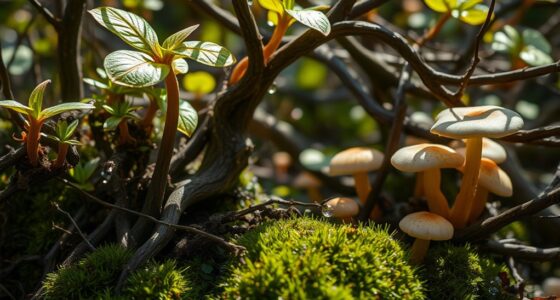The legend of the Tooth Fairy blends childhood dreams with ancient traditions that see teeth as connected to nature and spiritual bonds. Historically, plants and natural symbols like trees, herbs, and animals played roles in rituals involving teeth, representing renewal, protection, and health. Different cultures incorporate wild plants and folklore to honor this symbolism, revealing deep ties between teeth, nature, and cultural beliefs. Exploring this story further uncovers how nature and tradition continue to shape this charming myth.
Key Takeaways
- The Tooth Fairy’s lore is rooted in ancient cultural rituals involving teeth and natural symbols like plants and animal spirits.
- Wild plants like herbs and trees symbolize renewal, protection, and spiritual connection in myths related to teeth and folklore.
- Traditional rituals, such as burying teeth or placing them in natural elements, reflect ecological respect and spiritual beliefs.
- Cultural practices involving wild plants support oral health, healing, and reinforce sustainable relationships with nature.
- Modern adaptations of the Tooth Fairy concept often incorporate natural elements and ecological awareness rooted in historical traditions.
Origins and Cultural Roots of the Tooth Fairy
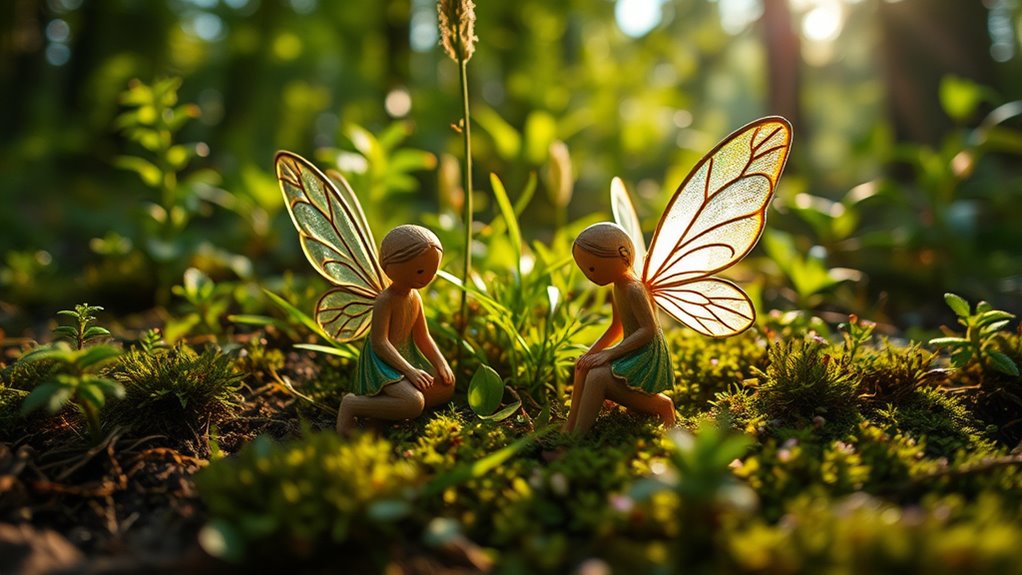
The origins of the Tooth Fairy trace back to various cultural beliefs and traditions that date as far back as the 17th century. In Scandinavian cultures, Vikings used children’s teeth and personal items in rituals, often offering their teeth to Odin for blessings. In medieval Europe, parents buried children’s lost teeth to protect them from evil spirits or witches. Meanwhile, in Hispanic traditions, children believe in “Ratoncito Pérez,” a mouse who collects their teeth, and in Japan, a tengu takes teeth and leaves rewards. These customs reflect a universal desire to mark a milestone and ensure protection or good fortune. Over time, these diverse practices blended, shaping the modern Tooth Fairy and spreading its magic across many cultures worldwide. Cultural Traditions continue to influence cultural beliefs surrounding this enchanting figure, highlighting how mythological legends evolve and adapt through generations. Additionally, oral traditions help preserve these stories and keep the magic alive in contemporary society. Recognizing the historical significance of these customs demonstrates how deeply rooted they are in human history and cultural identity.
Folklore and Natural Elements: The Role of Plants in Mythical Traditions
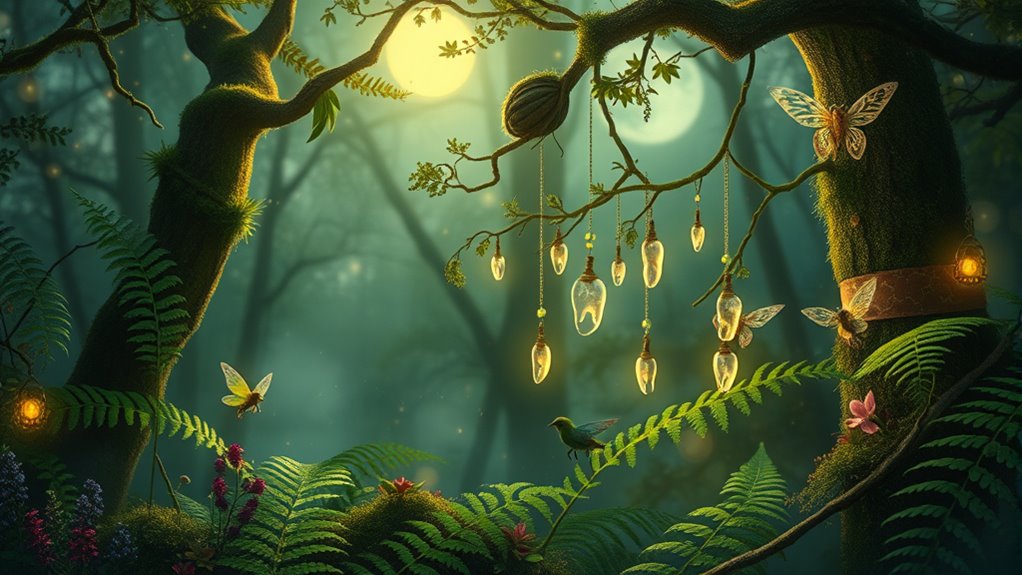
As cultural traditions evolved around the symbolism of objects like teeth, plants also gained significance in myths and folklore, representing more than just their physical presence. Sacred trees stand for wisdom and longevity, while herbs like chamomile symbolize calmness. Mushrooms reflect transformation because of their unique life cycle, and vines embody eternity and connection. Blossoms often signify renewal and rebirth in stories. Additionally, the use of multi-functional furniture in homes reflects a similar principle of versatility and adaptability found in mythic symbolism. Plants are deeply linked to earth, water, air, and fire elements, symbolizing fertility, spiritual transformation, resilience, and purification. They embody archetypes like maternal figures, healing deities, tricksters, nature spirits, and prophets. Their significance in cultural rituals underscores their vital role in connecting the physical and spiritual worlds. Moreover, the study of bicycle components reveals how intricate systems work together, much like the interconnected symbolism of plants in mythology. Recognizing the symbolic meanings of plants enhances our understanding of their lasting influence on human storytelling and spiritual practices. Furthermore, fostering backyard biodiversity by cultivating native plants can strengthen the cultural and spiritual connections people have with nature.
Plants, Healing, and Oral Health in Folklore Customs
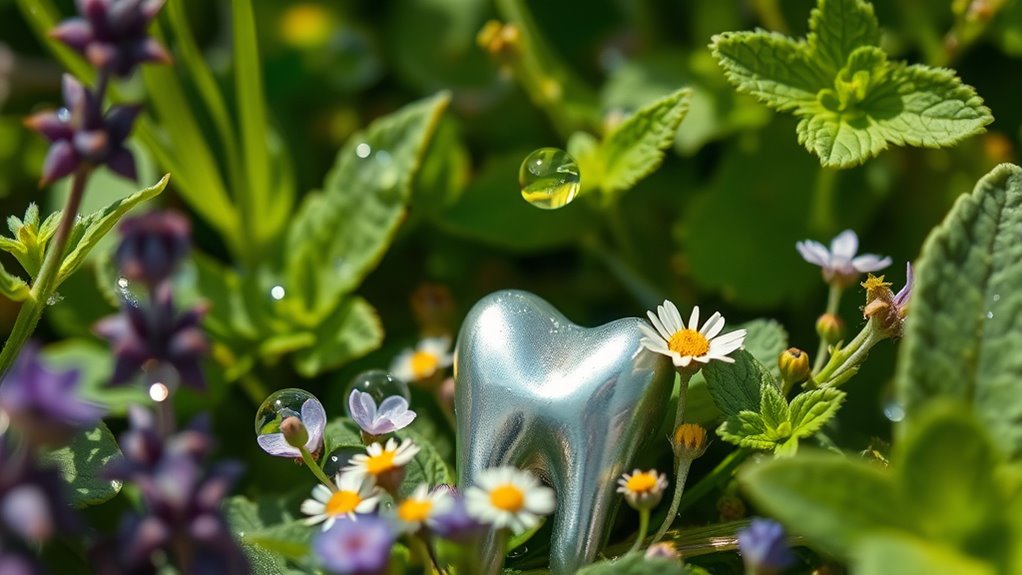
Plants have long played a crucial role in traditional healing practices, especially when it comes to oral health. You might’ve seen communities using Garcinia kola, or bitter kola, to soothe toothaches and mouth thrush.
Plants like Garcinia kola have traditionally eased toothaches and mouth thrush.
Herbal rinses made from Alchornea cordifolia help ease tooth pain, while decoctions of Pycnanthus angolensis are used for similar issues.
Eucalyptus saligna is applied as a paste to combat bad breath and tooth discomfort, and chewing Spilanthes africana flower buds relieves mouth odor and pain.
These plants often contain anti-inflammatory and antimicrobial properties, making them effective against oral infections, gingivitis, and ulcers.
Essential oils such as clove, tea tree, and lavender are also traditionally employed for their analgesic and antimicrobial benefits in oral health care.
Across cultures, such herbs are valued not just for their healing power but also for their role in traditional oral hygiene and folk medicine.
How Different Cultures Celebrate and Interpret Lost Teeth
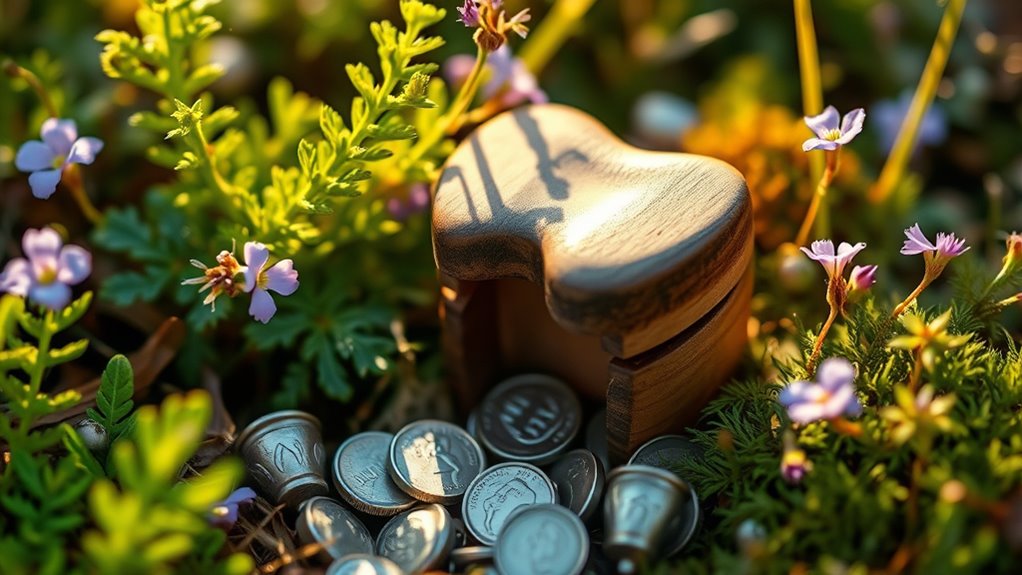
Across cultures, losing a tooth is more than just a physical event; it’s a meaningful milestone celebrated and interpreted in diverse ways.
In Western traditions, children place their teeth under pillows, receiving money from the Tooth Fairy, symbolizing growth and a gentle rite of passage.
Middle Eastern and North African customs involve tossing teeth onto rooftops or into the sun, hoping for stronger teeth and protection from evil spirits.
In South Asia, families bless and honor lost teeth, often placing them near altars or burying them to guarantee health and prosperity.
Central and Latin American cultures craft jewelry from teeth, representing protection and ancestral ties.
East Asian beliefs see dreams about losing teeth as omens of change, emphasizing spiritual significance.
Additionally, some cultures incorporate environmental considerations into their traditions, emphasizing respect for nature and sustainability, aligning with growing awareness about the importance of data privacy and responsible practices. Recognizing the cultural significance of teeth allows for a deeper understanding of how traditions adapt to contemporary values. Moreover, understanding the psychological aspects behind these customs can reveal insights into community bonding and individual identity. Exploring cultural symbolism further enriches our appreciation of these varied customs.
The Evolution of the Tooth Fairy and Its Connection to Nature
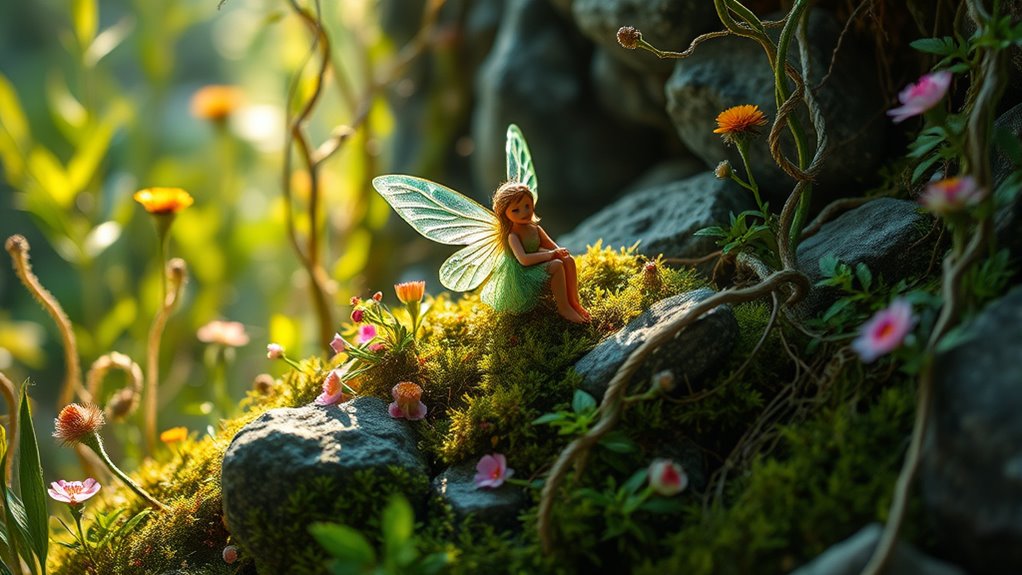
The evolution of the Tooth Fairy is deeply connected to humanity’s longstanding relationship with nature and ritual. In ancient times, cultures placed lost teeth in special bowls or buried them to seek protection or good fortune, often connecting these acts with natural elements like the ground or trees. Some believed burying teeth in the soil or tossing them onto roofs symbolized a link with natural structures, ensuring strength and health. Animal spirits, such as mice or birds, also played roles in these exchanges, emphasizing nature’s influence. These rituals reflected a belief that teeth held spiritual power and that nature could offer protection or blessings. Over time, these practices merged into stories and traditions that highlight the enduring bond between human health, magic, and the natural world. Recognizing these traditions reveals how cultural beliefs continue to influence modern symbols like the Tooth Fairy. Additionally, the use of natural elements in rituals underscores the importance of harmony with the environment in various cultural practices. Furthermore, the connection to cybersecurity highlights the importance of protecting personal information in today’s digital age, much like safeguarding traditional symbols and practices. This association demonstrates how ancient practices can inform our understanding of environmental harmony and the significance of respecting nature’s role in cultural rituals. It is also worth noting that many of these customs are inspired by the ancient healing practices that sought balance between humans and nature.
Wild Plants in Modern Practice and Their Symbolic Significance
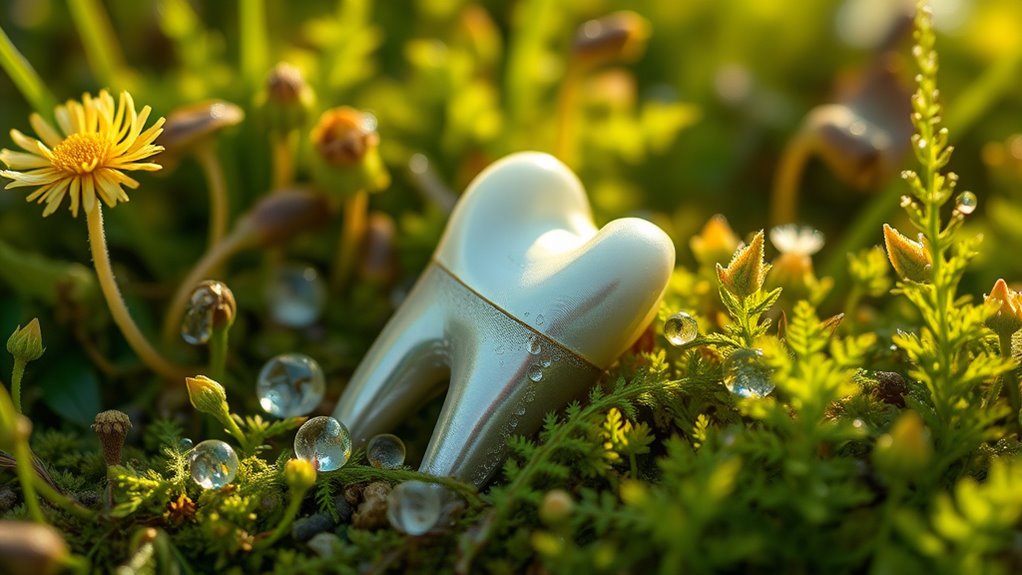
In today’s world, wild plants play an essential role in modern practices like foraging and sustainable food systems, connecting us to nature’s abundance. You can discover diverse wild plants that boost global food variety and provide critical nutrients often missing from processed foods, like vitamin C, calcium, and fiber.
Foraging promotes eco-friendly practices, reducing pressure on over-farmed lands and supporting local economies. Many wild plants hold cultural significance, symbolizing resilience and ecological balance, and are valued in herbalism for their medicinal properties. Conservation efforts are vital for maintaining plant populations and ensuring these resources remain available for future generations.
Sustainable harvesting methods, such as regulated collection and traditional knowledge, help preserve species and biodiversity. Employing traditional harvesting techniques ensures that wild plant populations remain sustainable and healthy for ongoing use. Additionally, understanding the ecological role of wild plants emphasizes their importance in maintaining healthy ecosystems and promoting biodiversity.
Incorporating wild plants into farm-to-table movements highlights their culinary and symbolic importance, reinforcing our connection to nature and heritage in a modern context. biodiversity is crucial for ecological stability and resilience, and protecting wild plants directly supports this diversity.
Understanding the nutritional value of wild plants can encourage more mindful and beneficial use of these natural resources.
Frequently Asked Questions
Are There Specific Wild Plants Traditionally Associated With Dental Healing?
You’re asking if specific wild plants are traditionally linked to dental healing. Many plants, like Myrrh gum, Clove buds, and Salvadora persica (used as chewing sticks), have long been used for their antimicrobial, anti-inflammatory, and pain-relieving properties.
These plants help treat gum diseases, freshen breath, and strengthen teeth. Their cultural significance and natural medicinal benefits make them essential in traditional dental care practices across various regions.
How Do Indigenous Cultures Incorporate Plants Into Their Tooth-Related Folklore?
You see, indigenous cultures incorporate plants into their tooth-related folklore by using them symbolically and medicinally. They place teeth in trees to promote growth, craft remedies from roots and leaves for toothaches, and embed plants with cultural meaning during healing rituals.
These practices connect natural forms and growth patterns with dental health, blending spiritual beliefs with botanical knowledge to preserve traditions and promote oral wellness.
Can Certain Herbs Be Used to Attract or Invoke the Tooth Fairy?
Imagine whispering to the night, hoping herbs might summon a magical visitor. While some believe herbs like lavender or sweet-smelling plants can attract fairies or spirits, there’s no solid evidence linking them specifically to the Tooth Fairy.
You might feel drawn to use herbs for their enchanting scent or protective qualities, but historically, herbs haven’t been used to invoke her directly. It’s more about creating a mystical atmosphere than a proven method.
What Wild Plants Symbolize Good Luck or Protection for Children’s Teeth?
You’re curious about wild plants that symbolize good luck or protection for children’s teeth. While specific plants directly linked to tooth protection are rare, herbs like lavender and mint are known for their calming and healing properties, which may promote oral health.
In some cultures, plants like herbs for protection are believed to ward off harm and bring good fortune, subtly supporting healthy teeth and overall wellbeing.
Are There Natural Remedies Involving Plants to Enhance Oral Health in Folklore?
You might be surprised, but many cultures turn to plants for oral health remedies that seem almost magical. You could chew Spilanthes africana to soothe a toothache or rinse with Garcinia kola for fresh breath, harnessing nature’s power.
These traditional practices are like hidden treasure chests filled with natural cures, proving that plants have been trusted for centuries to protect smiles and promote healthy teeth worldwide.
Conclusion
As you explore the rich history of the tooth fairy and wild plants, you’ll see how nature and folklore intertwine. Did you know that over 60% of cultures worldwide have some tradition related to lost teeth? By understanding these customs, you connect more deeply with the natural world and its magical stories. So next time you lose a tooth, remember, you’re part of a centuries-old tradition that celebrates nature’s healing power and cultural wonder.




